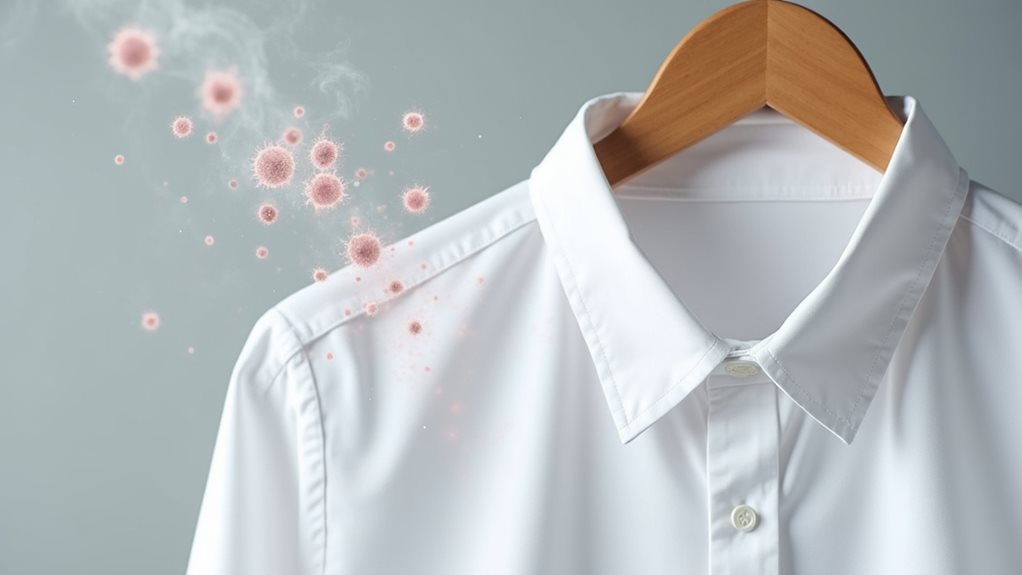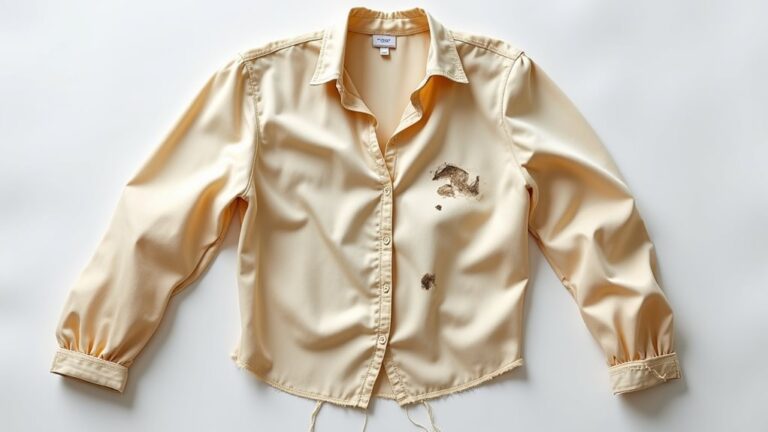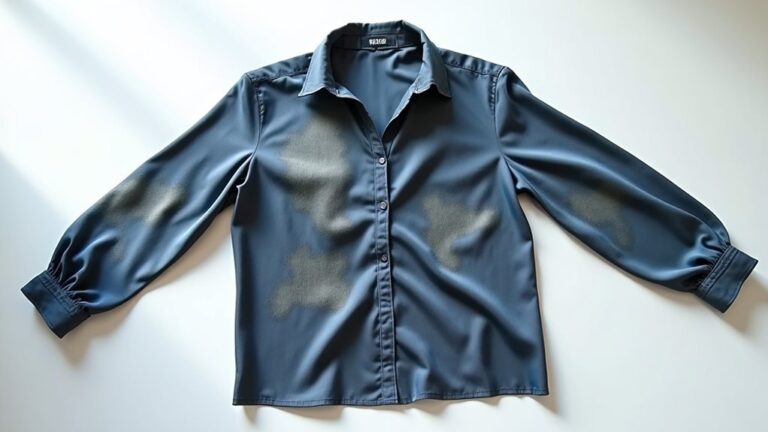You’ll be relieved to know that dry cleaning absolutely kills bacteria through its powerful combination of heated chemical solvents reaching 165°F and aggressive agitation that creates a hostile environment where pathogens simply can’t survive. I’ve learned that these temperatures far exceed your home washing machine’s 140°F maximum, while the chemical solvents penetrate fibers more effectively than water-based methods, guaranteeing even stubborn bacteria meet their demise. There’s much more to this sanitization story, though.
How Dry Cleaning Works to Eliminate Germs
When you’re wondering whether that expensive blazer or delicate silk dress actually gets sanitized at the dry cleaner, you’ll be relieved to know that the process does far more than just remove visible stains and odors.
The dry cleaning process creates a hostile environment for viruses and bacteria through its combination of heated chemical solvents and aggressive agitation. As your garments spin in that solvent-filled drum, temperatures climb up to 165 degrees Fahrenheit – hot enough to eliminate most pathogens lurking in fabric fibers.
What’s particularly reassuring is how the cleaning solution penetrates every thread and crevice, reaching areas that regular washing might miss. Fresh solvent batches for each load guarantee maximum sanitization, making dry cleaning surprisingly effective at killing germs.
However, while dry cleaning significantly reduces the microbial load on your garments, it’s not considered a sterilization method like the disinfection processes used in medical settings.
Temperature Requirements for Killing Bacteria
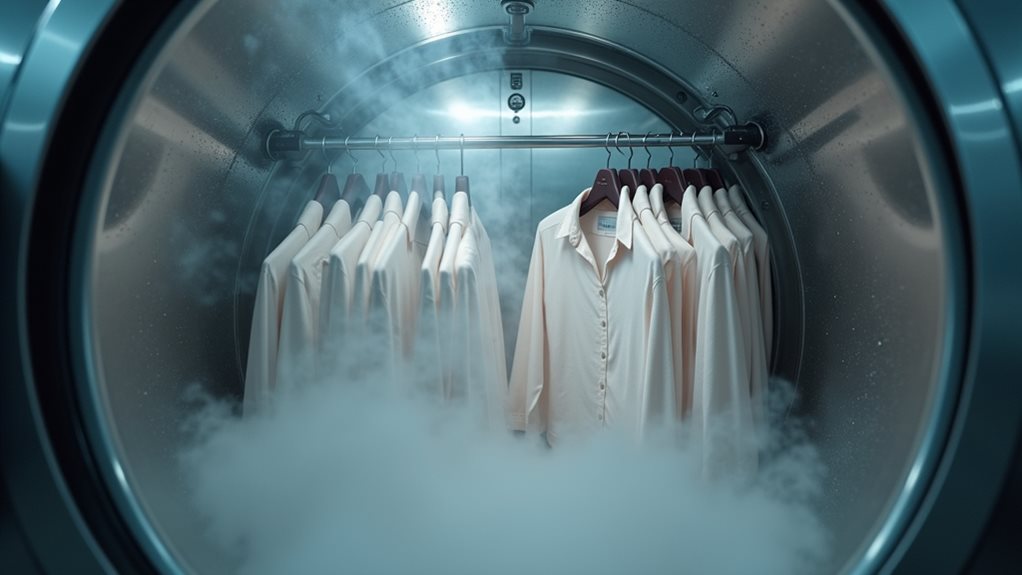
Temperature becomes your silent ally in the fight against bacteria, and understanding exactly how hot things need to get can put your mind at ease about whether your clothes are truly sanitized.
During the cleaning process, dry cleaners use high temperatures reaching up to 165°F, which effectively eliminates most bacteria and pathogens lurking in your favorite garments.
The final drying phase cranks things up even more, hitting 220°F – that’s hot enough to make bacteria wave the white flag! 🏳️
What’s particularly reassuring is that research shows the COVID-19 virus becomes inactive within just five minutes at temperatures above 158°F.
The combination of chemical solvents like perchloroethylene and these high temperatures creates a hostile environment that destroys most microorganisms during the dry cleaning process.
Chemical Solvents vs. Water-Based Cleaning Methods
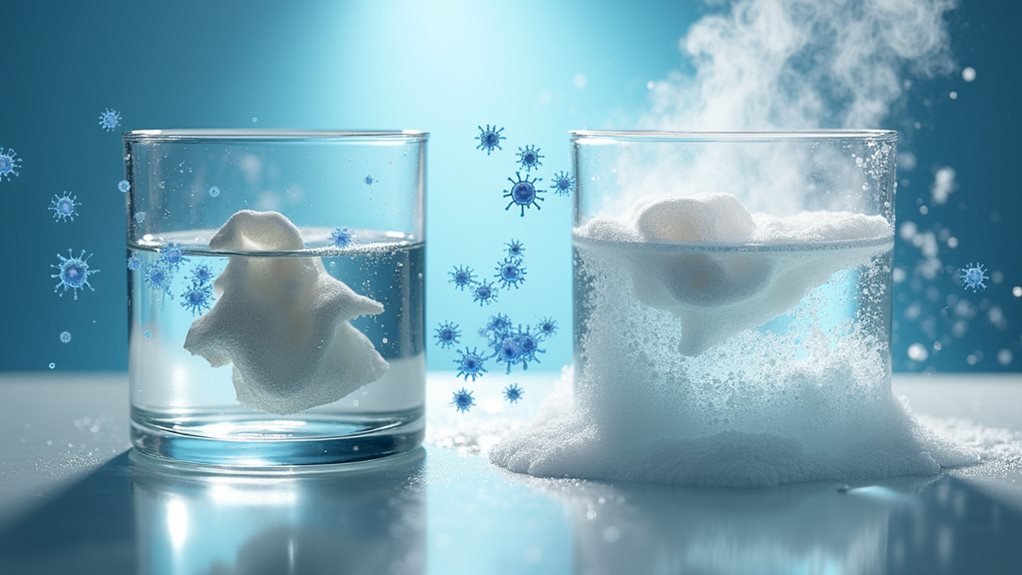
While both cleaning methods have their merits, the battle between chemical solvents and water-based approaches isn’t even close when you’re talking about bacteria elimination – and I learned this the hard way after a particularly unfortunate incident with a silk blouse and my home washing machine.
Chemical solvents penetrate every single fiber through mechanical agitation, something water-based methods simply can’t match. Those heated solvents reach temperatures up to 165 degrees, creating a bacteria-killing powerhouse that water washing struggles to achieve.
Plus, you’ll love knowing that fresh solvent gets used for each load, maintaining sanitation standards that keep cross-contamination at bay. However, many dry cleaning facilities are now adopting safer alternatives like wet cleaning and liquid CO2 to reduce health risks while maintaining effective cleaning power. Trust me, your delicate fabrics will thank you!
The Role of Heat in Bacterial Elimination
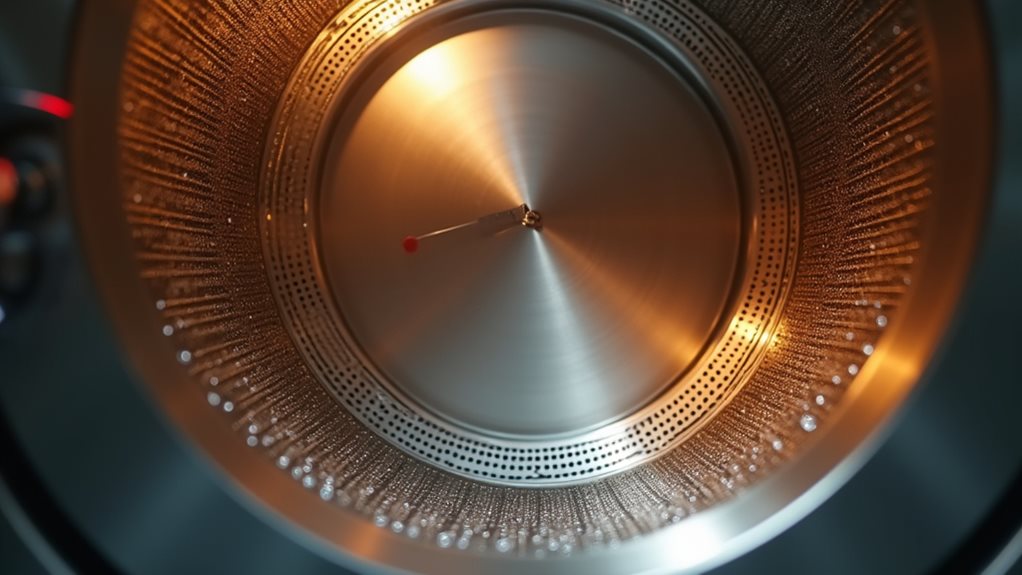
Beyond the power of chemical solvents lies an even more impressive bacteria-fighting weapon that transformed my understanding of garment sanitization – the incredible heat generated throughout the dry cleaning process.
When I first learned that dry cleaning reaches up to 220 degrees Fahrenheit, I was genuinely amazed because that’s notably higher than the WHO’s recommended 140-150 degrees for killing viruses.
This intense heat doesn’t just warm your clothes; it literally incinerates bacteria and viruses hiding in fabric fibers, creating a sterilization effect that water-based cleaning simply can’t match.
The final drying stage acts like a safety net, guaranteeing every last germ gets eliminated before you receive your clean clothes back, sparkling and sanitized. 🔥
However, it’s important to understand that dry cleaning’s primary purpose is fabric care rather than sanitization, and those requiring medical-grade sterilization should consider specialized disinfection services.
Professional Sanitization Standards in Dry Cleaning
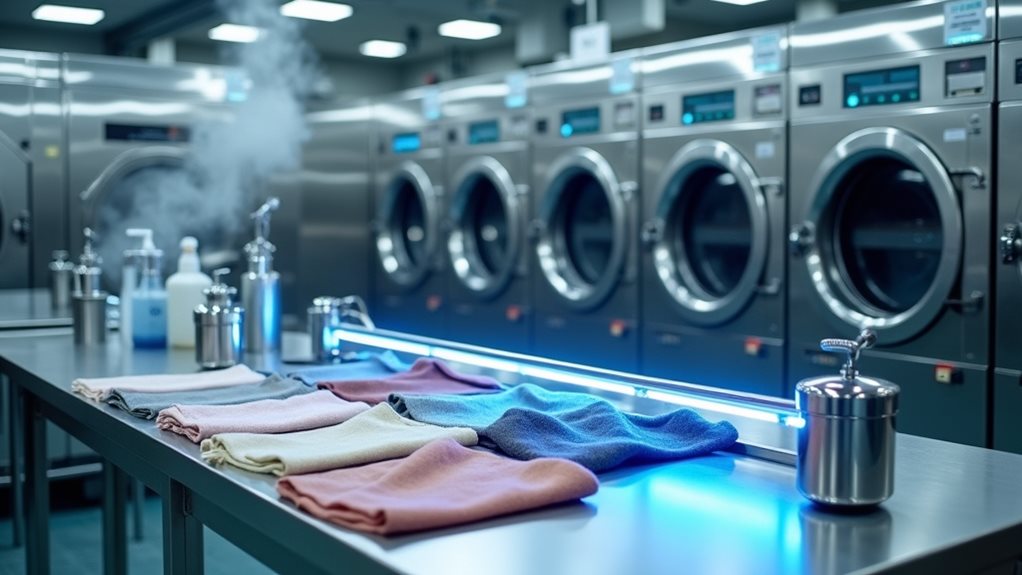
When you’re trusting your favorite blazer to a dry cleaner, you’ll want to know they’re following strict industry temperature requirements that mandate reaching at least 165 degrees Fahrenheit, because that’s the magic number where harmful bacteria can’t survive the heat.
Professional facilities must also comply with EPA safety protocols that govern everything from solvent handling to ventilation systems, guaranteeing your clothes come back not only clean but genuinely sanitized.
I’ve learned that reputable cleaners don’t just wing it – they follow these rigorous standards because your health, and their reputation, depends on getting the science right every single time.
Many modern facilities now offer eco-friendly cleaning methods such as wet cleaning and CO2 cleaning as alternatives to traditional chemical solvents for customers seeking safer sanitization options.
Industry Temperature Requirements
Since professional dry cleaners follow strict temperature protocols that I learned about during my own quest to understand garment sanitization, you’ll find that these industry standards aren’t just suggestions—they’re carefully calibrated requirements designed to eliminate harmful bacteria from your clothes.
When you get items dry cleaned, the heated chemical solvents must reach at least 165 degrees Fahrenheit during cleaning cycles, which honestly surprised me when I first discovered this temperature requirement.
The high temperatures don’t stop there though—drying phases can hit up to 220 degrees Fahrenheit, creating what’s fundamentally a double-layer defense against germs.
These aren’t arbitrary numbers; they’re EPA-approved benchmarks that guarantee your garments receive proper sanitization every single time.
For business owners who regularly dry clean work uniforms or specialized protective gear, these professional sanitization standards can be particularly important since such items may qualify as tax-deductible cleaning expenses when they’re required specifically for work purposes.
EPA Safety Protocols
While researching the regulatory side of dry cleaning, I discovered that EPA safety protocols create a thorough framework that goes far beyond just hitting the right temperatures—these standards actually govern every aspect of how professional cleaners handle your garments to guarantee maximum sanitization.
Think of it like a choreographed dance where every move matters: dry cleaners must use fresh solvent batches for each load, preventing any chance of cross-contamination between customers’ clothes.
Their employees wear protective gear religiously, treating your favorite sweater with the same care they’d want for their own belongings.
Unlike water temperatures in home washing, these chemical solvents work differently but more effectively, and regular EPA inspections verify your local cleaner isn’t cutting corners on safety.
These protocols are particularly important because perchloroethylene, the most common dry cleaning solvent, has been classified as a probable human carcinogen by the EPA and requires careful handling to minimize exposure risks.
Comparing Home Washing and Professional Dry Cleaning Effectiveness
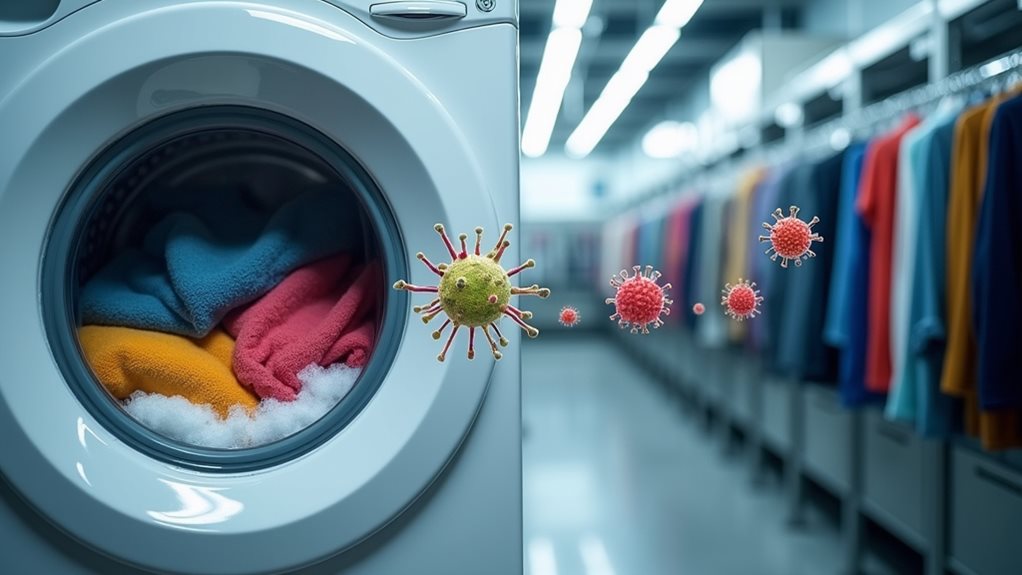
When you’re deciding between tossing your favorite blouse in your home washer or taking it to the dry cleaner, you’re actually choosing between two completely different approaches to eliminating bacteria—and trust me, the temperature differences alone will surprise you.
Your home washing machine, even on its hottest setting, typically maxes out around 140°F, while professional dry cleaning reaches scorching temperatures up to 165°F with chemical solvents that bacteria simply can’t survive.
The real game-changer isn’t just about getting your clothes clean (though we all want that fresh-laundry smell 😊), it’s about understanding how water-based cleaning compares to solvent-based methods when it comes to actually killing those microscopic troublemakers.
However, it’s worth noting that traditional dry cleaning uses perchloroethylene (PERC), which can leave chemical residues on garments that may pose health risks if clothes aren’t properly aired out after cleaning.
Temperature Differences Matter
Although most people assume their home washing machine gets hot enough to eliminate germs, the temperature differences between your laundry room and professional dry cleaning facilities reveal a fascinating gap that might surprise you.
Your washing machine typically reaches 140-150°F, which honestly feels pretty toasty when you’re transferring clothes, but professional dry cleaners crank up those chemical solvents to 165°F – that’s like the difference between a warm bath and a hot tub! 🔥
Then comes the real kicker: their drying temperatures soar to 220°F, guaranteeing your clothes emerge genuinely sanitized.
These temperature differences aren’t just numbers on a thermometer; they’re vital for making sure your clothes receive hospital-level cleanliness that your home setup simply can’t match.
The use of chemical solvents like perchloroethylene or eco-friendly alternatives during this high-temperature process ensures that even stubborn oil-based stains are eliminated along with harmful bacteria.
Solvent Vs Water Methods
Beyond temperature alone, the core cleaning methods tell an even more compelling story about bacteria elimination.
When you’re deciding between home washing and dry cleaning, you’re fundamentally choosing between two completely different approaches to germ warfare. Your washing machine relies on water and detergent to create a sudsy battlefield, which works well for everyday dirt and some bacteria, but it’s like bringing a butter knife to a sword fight when dealing with stubborn pathogens.
Dry cleaning’s solvent-based system, however, operates more like a specialized weapon designed specifically for bacterial elimination. The chemical solvents dissolve oils and proteins that bacteria cling to, while the mechanical action in this solvent environment creates conditions that are particularly hostile to microbial survival, especially on delicate fabrics. While perchloroethylene (PERC) remains the most commonly used dry cleaning solvent, it’s worth noting that the industry continues to evolve with safer cleaning alternatives.
Bacteria Removal Effectiveness
While my grandmother always swore that her trusty washing machine could tackle any germ imaginable, the scientific reality paints a different picture when we compare bacteria removal effectiveness between home washing and professional dry cleaning.
You’ll find that dry cleaning’s heated chemical solvents, reaching temperatures up to 165°F, create a hostile environment where bacteria simply can’t survive, while your home washer relies on water and soap that mightn’t achieve the same lethal temperatures.
The steaming process in professional garment care adds another layer of sanitization, fundamentally giving your clothes a bacteria-busting double whammy.
When you consider that dry cleaners use fresh solvent batches for each load, you’re getting maximum bacteria removal without the cross-contamination risks that can occur with traditional washing methods.
Safety Protocols Used by Professional Cleaners
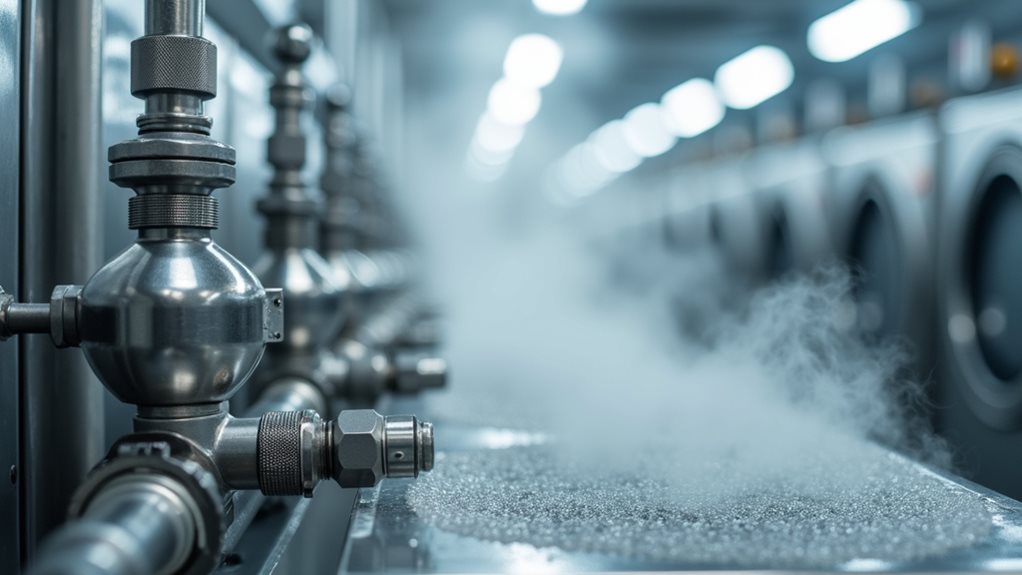
When I first started researching dry cleaning safety protocols, I’ll admit I was skeptical about whether professional cleaners really took the necessary precautions to protect both their workers and your clothes from harmful bacteria.
However, after digging deeper, I discovered that reputable facilities implement thorough safety protocols that truly impressed me. This systematic approach helps prevent cross-contamination while guaranteeing worker safety.
Professional cleaners don’t mess around when it comes to protection:
- Workers suit up in full PPE gear including gloves, safety goggles, and masks during every shift
- Fresh solvent batches are used for each load, eliminating any chance of transferring germs between customers’ clothes
- Routine workplace sanitization happens throughout the day, creating multiple barriers against bacterial spread
These protocols create a fortress-like environment against harmful microorganisms.
When to Choose Dry Cleaning for Maximum Disinfection
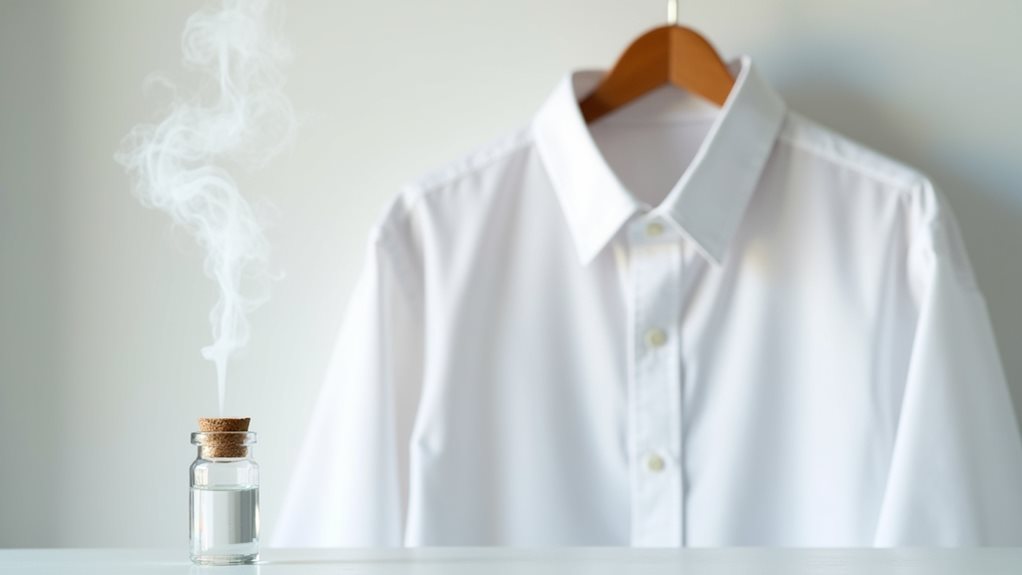
Since discovering how powerfully effective dry cleaning can be at eliminating bacteria, I’ve completely changed my approach to deciding which clothes deserve this premium treatment, and honestly, it’s made me feel so much more confident about protecting my family’s health.
Now I prioritize dry cleaning for items that’ve been exposed to illness, like my husband’s work shirts during flu season, or anything worn to medical appointments.
I now send clothes to dry cleaning after any potential exposure to germs or illness for extra peace of mind.
You’ll want to choose dry cleaning when regular washing might damage delicate fabrics that need deep sanitization, since the heated solvents remove dirt while simultaneously killing harmful microorganisms.
I’ve learned that garments requiring both preservation and maximum disinfection—think wool coats after travel or silk blouses worn to crowded events—benefit most from this thorough, bacteria-eliminating process. 😊

